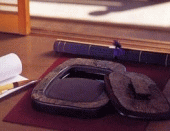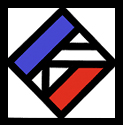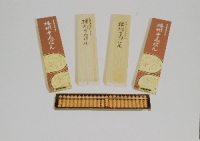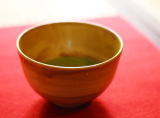
photo by Tohoku Bureau of Economy, Trade and Industry |
OGATSU SUZURI |
| (Miyagi)/suzuri, flower vase, paper weight, photo falme |
| In the oral tradition is said to have been made from over 600years ago
when was Muromachi Period. Recently reuse shavings of the inkstone(industrial
waste) was use to produce color stone as combined crafts like resin mix. |
| |

photo by Kansai Bureau of Economy,Trade and Industry HP,Traditional Crafts
information page |
ECHIZEN WASHI |
| (Fukui)/paper, letter |
| Echizen Washi has been already used for the Buddhist Sutras in the Nara Period. There are many kinds. It got a reputation as a high-quality paper. It was designated as a Traditional Craft by Japanese Government in 1976. |
| |
|
photo by Tottori Prefectural Government HP, Tottori Traditional Arts & Crafts information TORINET |
INSYUU WASHI |
| (Tottori)/paper, letter, interior, lantern cover |
| Its origin wasn't certainly, but It wasv gussed to be born before Nara
Period. It was old traditional paper. Especially, high-quality handmade
papers of images are proud of the production volume in Japan in particular.
It is used well by many lovers or caligraphers. It was designated as a
Traditional Craft by Japanese Government in 1975. |
| |
|
photo by Tottori Prefectural Government HP, Tottori Traditional Arts & Crafts information TORINET |
IZUMO ISHI DOUROU |
| (Tottori)/stone lantern |
| Its origin was Heian Period. It is used the soft fine-particle"Kimachi
stone". It will be tinged with blue patina moss as soon as color.
In addition, it has the advatage of easy to process on the excellent heat
&cold resistance, it is difficult to weathering. It was designated
as a Traditional Craft by Japanese Government in 1976. |
| |

photo by Tottori Prefectural Government HP, Tottori Traditional Arts & Crafts information TORINET |
TSUTSUGAKI |
| (Tottori)/good catch flag |
| It is a technique to draw the outline of the pattern on the fabric by extruding
glue from the tip of the tube. That glue prevent dyed. Its technique is
called TSUTSUGAKI. The largest of the order is good catch flag. It was
designated Tottori specified technology. |
| |
photo by Okayama Prefectural Government~The country of sunny photp by studio~Okayama
Prefectural Government HP, Traditional Crafts information page |
TAKADA SUZURI |
| (Okayama)/suzuri |
| It have a tradition from the Muromachi Period. It is characterized shiny
jet black. Material is the black slate of local produce and finished taking
advantage of the shape of a gemstone. Products with the pattern called
"gold eye" and "silver thread" have been prized as
a gem in particular. It was designated Okayama specified technology in
1982. |
|
photo by Yamaguchi Prefectural Government HP, Yamaguchi Brand Museum |
AKAMA SUZURI |
| (Yamaguchi)/suzuri |
| AKAMA SUZURI is known as the luxury goods. Its history is said to date
back to the Kamakura Period. It was Made by Akamaishi that is beautiful
stone. Ink that have smoked by Akama Suzuri is suitable the fine representation
as Kana characters. It was designated as a Traditional Craft by Japanese
Government in 1976. |
| |
photo by Ehime Prefectural Government HP, Ehime good products picture book |
OOZU WASHI |
| (Ehime)/paper, card |
| About the record of its can be seen in the book"ENGI SHIKI" as
wrriten by in the Heian Period. It has a tradition and long history. In
particular, its quantity of calligraphy hanshi has been referred to as
in Japan. Calligraphy hanshi with ink or slip of brush is good when it
comes to "die(KARERU)" in the state have passed 3 or 4years from
the paper can. It was designated as a Traditional Craft by Japanese Government
in 1977. |
| |
photo by Ehime Prefectural Government HP, Ehime good products picture book |
SENKA SHI I |
| (Ehime)/paper, folding screen, sliding door |
| It was born a cardboard in Tensho year in Edo Period. 2sheets of paper
bonded after sucking immediately, it finished in a piece of paper. It had
been praised as a masterpieces of world from robustness. |
| |
|
photo by Ehime Prefectural Government HP, Ehime good products picture book |
SEABORN ART |
| (Ehime)/lantern, acecceries, decolating plate |
| It means of Art was born from the sea. There are "Stained Glass"that
is combination of glass and shells,"Marin Glass" that make lamp
shade by stacking the recycled glass and "Seaweed Art"that is
framed of seaweed. It is using the blackberry lilly shell of specialty
of Ehime. |
| |
|
photo by Ehime Prefectural Government HP, Ehime good products picture book |
IYO NO MIZUHIKI |
| (Ehime)/lanyard |
| MIZUHIKI is the beautiful decoration string of multicolored. Mizuhiki in
Iyo began from MOTOYUI in Heian Period. MOTOYUI is string of hair ornament.
Now it is used in betrothal commonly. Recently brooches, strap, hair ornament
are also made from a few years ago. |
| |
|
photo by Ehime Prefectural Government HP, Ehime good products picture book |
TSUTSUGAKI ZOME |
| (Ehime)/good catch flag, banner, hanten |
| It is a technique to draw the outline of the pattern on the fabric by extruding
glue from the tip of the tube. That glue prevent dyed. Place glue painting
is also drawing tube. It is a widespread technique in the Edo Period. Its
technique is called TSUTSUGAKI. It was designated Ehime specified technology. |
| |
photo by Ehime Prefectural Government HP, Ehime good products picture book |
GIRUDING |
| (Ehime)/vase, frame, rapping sheat, lamp shade |
| It is method for performing a design to use metal foil on paper or wood.
Its method can be used a lot of decoration, handicrafts and repair. It
have received technical quidance from wallpaper designer living in Paris.
Products are card case, book cover, vase, photo frame, coaster and lanp
shade. The Exhibitions in overseas it has been attracting attention for
its beautiful and ingenious hue. |
| |
|
photo by Ehime Prefectural Government HP, Ehime good products picture book |
IMAHA MUKASHI UCHIKO IRO ANDON |
| (Ehiem)/lighting funiture |
| It is the lighting furniture by "meeting of Uchiko hand work"
was produced. It was use wood wax,Japanese paper, Japanese candle without
using nails. Although it can enjoy at least 1cube. But it can be the contest
of the flame by connecting the cube, assembled in vertial and horizontal
as buidling blocks, slide the cube..etc. There are many ways to enjoy. |
| |

photo by Fukuoka Prefectural Government HP, Traditional Craft page |
YAME CHOUCHIN |
| (Fukuoka)/lantern |
| It is the biginning in 1816. Bunemon Aramaki made the rustic lantern with drawing flowers. It was said BACHOUCHIN. YAME CHOUCHIN is rich in tasteful emotional taste. It delivered across overseas widely. Its main producin area is Yame city. It was designated as a Traditional Craft by Japanese Government in 2001. |
| |

photo by Nagasaki Prefectural Government HP, Nagasaki Traditional Craft
Page and Toukei kids |
 WAKATA ISHI SUZURI WAKATA ISHI SUZURI |
| (Nagasaki)/suzuri |
| It has so long history. It is said to have been used when Shikibu Murasaki
wrote the 54 chapter of the Genji Story in Heian Period. It is characterized
warm and wet type stone, also ink is coming out clean. And For natural
ink stone without pattern by hand, It is used as ornaments. It was designated
as a Nagasaki specified technology craft in 1991. |
| |

photo by Hyougo Prefectural Government, Industrial Labor Department |
BANSYUU SOROBAN |
| (Hyougo)/abacus |
| It was Japanese abacus that made from traditional technology. It have a
good reputation in the exquisite feel. It was designated as a Traditional
Craft by Japanese Government in 1976. |
| |
copyright |
 MIYAGINO HAGIFUDE MIYAGINO HAGIFUDE |
| (Miyagi)/brush |
| SENDAI OFUDE was born about 400years ago. Masamune Date who was the first Lord of Sendai was encouraged. The material in the Hagi that clumps Miyagino. It is suitable for letters, haiku and tanka cause be a fine brush. |
| |
copyright |
YAMAGATA BUTSUDAN |
| (Yamagata)/buddhist altar |
| Yamagata buddhist altar has history for 250years. It was finished in a
comprehensive manner by the division of seven departments. They are wooden
basis, palade, sculpture, bracket, coating, tooled, picture. It was designated
as a Traditional Craft by Japanese Government in 1985. |
| |
copyright |
AIZU EROUSOKU |
| (Fukushima)/painting candle |
| AIZU EROUSOKU was born in 500years ago. White candle is made from real
lacsquer, and painting a picture of colorful flowers such as peony and
plum. Recently it was used Hazerou. Laborious process which the core wound
with a rush in the paper, and let pass through into the thick wax for many
times is the same as before. |
| |
copyright |
KAMIKAWAZAKI WASHI |
| (Fukushima)/paper, letter, paper lantern, sliding door |
| It was born in Heian Period about for 1000years ago. Referred to as the
paper of Michinoku. It is said that it was MAYUMIGAMI which Seishonagon
and Murasakishikibu would prefer to use. Papermaking is made of NAGASHISUKI
that is unique method only Japan. |
| |
copyright |
IWAKI ENOBORI |
| (Fukushima)/flag |
| It was a custom of hope that the boy grew up strong and healthy with decorating IWAKIENOBORI. It has all finished with hand-painted and be valuable. |
| |
copyright |
GIFU CHYOUTIN |
| (Gifu)/lantern |
| It was made at the middle of the 18th century at first. It was used widely
for OBON or the goods of coolbiz. It was designated as a Traditional Craft
by Japanese Government in 1995. |
| |
copyright |
ISE KATAGAMI |
| (Mie)/interior&textile pattern |
| It originated from Muromachi Period. It is used in dyeing of pattern and
pattern of kimono. Its design is dense and elaborate. It was designated
as a Traditional Craft by Japanese Government in 1983. |
| |
copyright |
 TSUZURE NISHIKI TSUZURE NISHIKI |
| (Shiga)/crape wrapper, drop curtain, float, bag, stole |
| It is known variously Nail weaving. It weaves each yarn such as the thickness
of the yarn sewing thread by nail. All handmade, and Advanced technology
and long time is reqired. It was designated as a Traditional Craft by Shiga
Prefectural Government. |
| |
copyright |
KYOU BUTSUDAN・KYOU BUTSUGU |
| (Kyoto)/buddhist altar, buddhist altar fittings |
| History of Buddhist altar fittings started in the 6th century. And the
habit of the Buddhist altar enshrined in each home became widespread during
Edo Period. Kyoto is the center of production and Buddhist altar until
now. As well as production volume, quality and superior technology has
been maintained. It was designated as a Traditional Craft by Japanese Government
in 1976. |
| |
 D.D.Revolution
D.D.Revolution



































